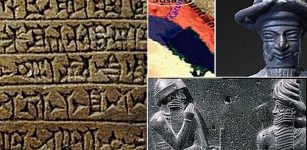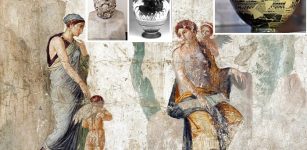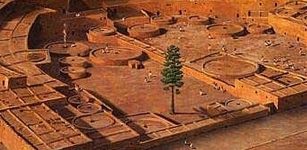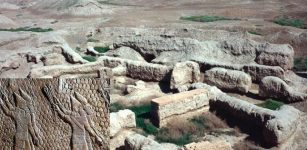How Henry VIII Accidentally Changed The Way We Write History
AncientPages.com - In 1534, King Henry VIII infamously broke away from the Catholic Church, becoming the head of the Church of England. Following this, two lesser-known acts were passed, the Suppression of Religious Houses Act 1535 and the Suppression of Religious Houses Act 1539 (also known as the “two Acts of Dissolution”).
Portrait of Henry VIII - After Hans Holbein the Younger (1497/1498–1543). Walker Art Gallery
These acts were the legal instruments of what is now known as the dissolution of the monasteries, a long process throughout which the hundreds of priories, convents, friaries, and other religious houses which fell under the English monarch’s rule saw their holdings confiscated by the Crown. In doing so, Henry unwittingly set in motion a series of events that would forever change how scholars of English history would access the primary sources used in research.
Because monasteries had served various roles throughout history, the dissolution had wide-ranging consequences. It changed the landscape of England, with religious buildings slowly entering private hands – but it also changed the scholarly landscape.
Many of Britain’s early historians came from monasteries (often in the form of chroniclers), including Gerald of Wales, Bede the Venerable and Roger Bacon. As record-keepers, they also preserved the primary sources that continue to be studied by researchers today.
Manuscripts, like the religious houses’ other possessions, slowly changed hands in the decades following the dissolution. The king took several manuscripts for himself and more were taken and hidden by former members of the orders, or local inhabitants. Likely thousands disappeared.
The extent of the loss, while difficult to estimate, was extensively researched by Anglo-Saxonist and palaeographer (historical handwriting analysis expert) Neil Ripley Ker in his book, Medieval Libraries of Great Britain which was first published in 1941. This research is now available as a continually updated database through the combined efforts of current scholars.
Where did the manuscripts go?
Over the past decades, bibliographical research has shown that some were gathered by local, and often little-known, collectors. As for the rest, the writings of contemporary antiquaries (the people interested in the material remains of the past) provide precious information on what existed before the dissolution took place, how much disappeared, and how.
From 1533, English poet and antiquary John Leland undertook the arduous task of inventorying the most important manuscripts from the monastic houses, listing his work to date in a then-unpublished address commonly known as the Newe Yeares Gyfte, in 1546. Meanwhile, Leland’s associate John Bale compiled a Summary of the Famous Writers of Great Britain, founded upon Leland’s work and first published in Latin in 1548, for which the preparatory notes survive in Oxford’s Bodleian Library.
Left: John Leland by Thomas Charles Wageman (1824). National Portrait Gallery; Right: Robert Cotton by Cornelis Janssens van Ceulen (c. 1629). Trinity College, Cambridge
Bale’s preface to the Newe Yeares Gyfte tells us that many of the manuscripts ended up cut up for use as candlesticks or boot polishing cloth, some were sold to foreign nations, and many to book binders.
Such recycling had already taken place in the past. The membrane (treated animal skin, also known as parchment or vellum) from which most manuscripts were made could be reused to make new books, notably as binding material, and also had less obvious but not less useful afterlives. It would continue for many years to come, too. Notably, one of the copies of the Magna Carta allegedly had to be rescued from a tailor’s shop in 1629.
The Magna Carta in question found its way into the collection of antiquary Sir Robert Cotton. Like other collectors before him, Cotton sought to preserve the witnesses of British history, in particular, the now-dispersed monastic manuscripts. His collection still survives today, as the Cotton manuscripts became one of the foundational collections of the British Library.
The dissolution itself came at a turning point in historical methods. The 16th century saw the spreading through England of a new intellectual movement coming from Italy, where it had begun over a century earlier: humanism. Renaissance humanism was concerned (at first) with the study of the classical world, eventually producing a new culture of learning involving the re-evaluation of historical sources (including the aforementioned manuscripts).
On the continent, this often involved consulting the texts in the monasteries themselves. In England, where the monasteries no longer existed, these sources found their ways into the hands of the scholar-collectors who wished to use them, like Matthew Parker and Cotton.
Neither Parker nor Cotton limited themselves to gathering these documents. Their libraries were the centre of research circles, which used, edited, and sometimes published original manuscripts using another continental creation – the printing press. While antiquaries were not necessarily historians, and have generally been considered more interdisciplinary, their work facilitated historical research through both the preservation and the dissemination of primary sources.
Historical research has evolved a lot since the 16th century. The sources saved from destruction or dispersion at the time of the dissolution have been read, re-read, translated, studied, and contextualised in many ways since the days of the early antiquaries.
Henry VIII may have never intended to endanger these manuscripts. However, it is indisputable that the dissolution had a profound effect on English and indeed British scholarship, marking the minds of budding humanistic historians, and giving them unprecedented access to original documents.
Besides its impact on the historiography of its time, the dissolution could have drastically changed the sources we continue to use. Without the preservationist impulse of collectors, the surviving manuscripts may have well disappeared into tailor and cobbler shops, never to be seen again.
More than just a story of loss and destruction, the dissolution is also the story of efforts, both big and small, collective and individual, to preserve a country’s heritage in a time of great change and uncertainty.
Provided by The Conversation
This article is republished from The Conversation under a Creative Commons license. Read the original article.
More From Ancient Pages
-
 Steamship SS Mesaba Sent Warning To RMS Titanic In 1912 – Her Wreck is Now Identified
Archaeology | Sep 27, 2022
Steamship SS Mesaba Sent Warning To RMS Titanic In 1912 – Her Wreck is Now Identified
Archaeology | Sep 27, 2022 -
 On This Day In History: Army Of Tsar Alexander I Of Russia Enters Paris – On March 31, 1814
News | Mar 31, 2016
On This Day In History: Army Of Tsar Alexander I Of Russia Enters Paris – On March 31, 1814
News | Mar 31, 2016 -
 Who Or What Made These Mysterious Holes At The Bottom Of The Atlantic Ocean?
News | Mar 23, 2023
Who Or What Made These Mysterious Holes At The Bottom Of The Atlantic Ocean?
News | Mar 23, 2023 -
 Susa: One Of The World’s Oldest Cities That Served As Capital Of The Elamite Empire
Featured Stories | Oct 14, 2023
Susa: One Of The World’s Oldest Cities That Served As Capital Of The Elamite Empire
Featured Stories | Oct 14, 2023 -
 Mysterious And Frightening Sculptor’s Cave Of The Picts Reconstructed In 3D Model
Archaeology | Dec 10, 2017
Mysterious And Frightening Sculptor’s Cave Of The Picts Reconstructed In 3D Model
Archaeology | Dec 10, 2017 -
 Aphrodite Signified More Than Beauty – Five Other Realms In Which The Greek Goddess Also Reigned
Featured Stories | Sep 18, 2024
Aphrodite Signified More Than Beauty – Five Other Realms In Which The Greek Goddess Also Reigned
Featured Stories | Sep 18, 2024 -
 Ponderosa Pine: Life And Death Of One Of America’s Most Mysterious Trees
News | Mar 18, 2020
Ponderosa Pine: Life And Death Of One Of America’s Most Mysterious Trees
News | Mar 18, 2020 -
 New Discoveries Regarding Gladiatorial Games In Roman City Of Carnuntum
Archaeology | Apr 7, 2017
New Discoveries Regarding Gladiatorial Games In Roman City Of Carnuntum
Archaeology | Apr 7, 2017 -
 Few Witches Were Executed In Wales In The Middle Ages – Why?
Featured Stories | Oct 29, 2024
Few Witches Were Executed In Wales In The Middle Ages – Why?
Featured Stories | Oct 29, 2024 -
 Rudra – Mighty Hindu God Of Death, Destruction, Hunting Who Heals Mortal Diseases
Featured Stories | Aug 10, 2021
Rudra – Mighty Hindu God Of Death, Destruction, Hunting Who Heals Mortal Diseases
Featured Stories | Aug 10, 2021 -
 Lost Kingdom Of Mari – Once Important Commercial And Political Center Of Mesopotamia
Featured Stories | Jan 25, 2018
Lost Kingdom Of Mari – Once Important Commercial And Political Center Of Mesopotamia
Featured Stories | Jan 25, 2018 -
 Cooking, Roasting And Eating Of Root Plants Is 120,000-Year-Old Habit
Archaeology | Jun 7, 2019
Cooking, Roasting And Eating Of Root Plants Is 120,000-Year-Old Habit
Archaeology | Jun 7, 2019 -
 Unique, Well-Preserved 4,000-Year-Old Boat Discovered Near The Ancient City Of Uruk
Archaeology | Apr 4, 2022
Unique, Well-Preserved 4,000-Year-Old Boat Discovered Near The Ancient City Of Uruk
Archaeology | Apr 4, 2022 -
 Ancient Ruins Of Hovenweep: Impressive Puebloan Masonry
Civilizations | Mar 15, 2016
Ancient Ruins Of Hovenweep: Impressive Puebloan Masonry
Civilizations | Mar 15, 2016 -
 Biblical City In Zanoah Offers Archaeological Evidence Of Moses’ Journey To The Promised Land
Archaeology | Jul 18, 2024
Biblical City In Zanoah Offers Archaeological Evidence Of Moses’ Journey To The Promised Land
Archaeology | Jul 18, 2024 -
 Mysterious Ancient Inscription With Unknown Language Found Near Lake Bashplemi, Georgia
Linguistic Discoveries | Dec 4, 2024
Mysterious Ancient Inscription With Unknown Language Found Near Lake Bashplemi, Georgia
Linguistic Discoveries | Dec 4, 2024 -
 Ancient Bone Reveals Syphilis May Have Originated In The Americas – Columbus Theory Questioned By Scientists
Archaeology | Dec 20, 2024
Ancient Bone Reveals Syphilis May Have Originated In The Americas – Columbus Theory Questioned By Scientists
Archaeology | Dec 20, 2024 -
 Suomenlinna Fortress: Impressive ‘Castle Of Finland’ Has Rich History
Featured Stories | Feb 13, 2016
Suomenlinna Fortress: Impressive ‘Castle Of Finland’ Has Rich History
Featured Stories | Feb 13, 2016 -
 On This Day In History: Thor Heyerdahl Sails From Morocco On Papyrus Boat Ra II To Barbados – On May 17, 1970
News | May 17, 2016
On This Day In History: Thor Heyerdahl Sails From Morocco On Papyrus Boat Ra II To Barbados – On May 17, 1970
News | May 17, 2016 -
 Aurelian Walls Built By Emperor Aurelian Who Tried To Lead Roman Empire Out Of The Crisis
Featured Stories | Apr 16, 2018
Aurelian Walls Built By Emperor Aurelian Who Tried To Lead Roman Empire Out Of The Crisis
Featured Stories | Apr 16, 2018


